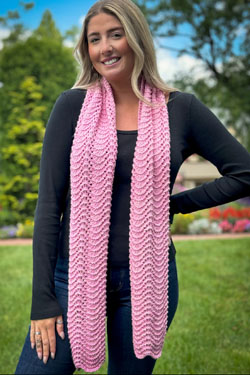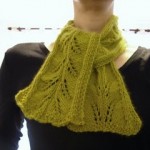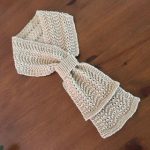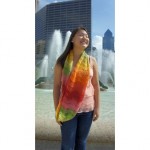Free Knitting Pattern for a Feather & Fan Scarf, featuring a classic lace pattern and two-piece construction.
This elegant scarf utilizes the traditional Feather & Fan lace pattern, creating a beautiful, undulating texture. The scarf is worked in two identical pieces, which are then grafted together using the Kitchener stitch for a seamless finish. The pattern uses a soft fingering weight yarn.
This design, rated as easy, uses the Feather and Fan stitch.
This pattern is rated as easy. While it involves yarn overs and decreases (k2tog), the Feather & Fan pattern is relatively simple and repetitive. The most challenging aspect might be the Kitchener stitch grafting, but many online resources can guide you through this technique. You will need Sea Isle yarn and US size 8 needles.
Skill Level: Easy (Yarn overs, decreases, Kitchener stitch grafting – optional)
Size:
- Approximate Dimensions: 10 x 60 inches
Materials Used:
- Sea Isle: 2 – 100g hanks, shown in color 4 Rosewater
- Needles: US 8 (5mm) needles

Knitting Pattern for the Sea Isle Feather and Fan Scarf.
Free Pattern
Pattern Considerations:
- Gauge: The specified gauge is 18 sts = 4 inches in pattern using US size 8 needles. Achieving the correct gauge is important for the finished size and drape of the scarf.
- Yarn Substitution: If you use an alternative yarn, use fingering weight yarn.
- Feather & Fan Pattern: The core of the design is a 4-row repeat. Pay close attention to the placement of the yarn overs (YO) and decreases (k2tog) to create the characteristic wave pattern.
- Two-Piece Construction: The scarf is made in two identical pieces. This simplifies the knitting process and allows for a longer scarf without requiring extremely long needles.
- Grafting (Kitchener Stitch): The two pieces are joined using the Kitchener stitch, which creates an invisible seam. If you are unfamiliar with this technique, there are many helpful tutorials available online (videos are often the easiest to follow). Alternatively you could bind off, and sew together.
- Garter Stitch Edging:
Rows 2 and 3 are Knit.
Row 4 has a garter stitch edging: K3, P54, K3. - Blocking: Blocking is recommended to open up the lace pattern and achieve the final dimensions. It is especially important to “flatten at the graft” to ensure a smooth join.







